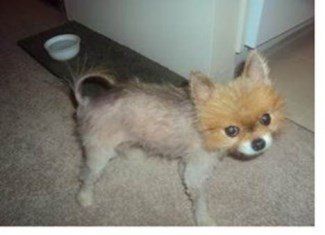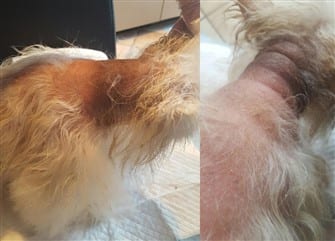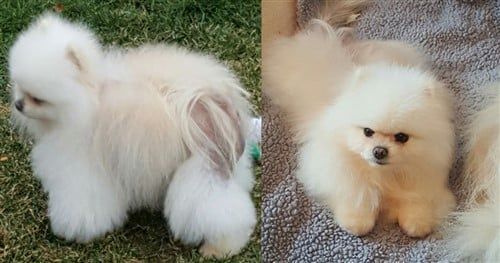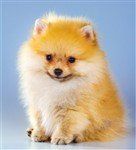Pomeranian Black Skin Disease (BSD)
Understanding BSD
BSD is a type of fur loss and it is seen with the Pomeranian breed. Those who have dealt with this before dread hearing the term. However, it is important for Pom owners to know about Pomeranian BSD, otherwise known as Black Skin Disease.
When a Pom has this, it is a gradual loss of fur. The stages of it normally occur as so:
1.
The puppy or dog will have odd patches of fur that looks distinctly different than other areas. The fur will be short and often has the appearance and texture of wool.
2.
Those spots will begin to thin out.
3.
The fur, over the course of a few weeks to a few months, will continue to fall out until it reaches the point of those areas being completely void of fur and only skin remains in those areas.
4.
Despite the name, the dog’s skin does not always turn to a black color. If it does turn black it can often slough off to some degree with the use of certain products. In some cases, the skin will remain pink. Being exposed to sunlight, without proper protection, can then lead to permanent color changes to the skin, making it appear black.
BSD is also sometimes incorrectly referred to as Alopecia X which simply means “unexplained fur loss". The cause of Black Skin Disease BSD is somewhat unknown - more research needs to be done-, however it is a very specific type of fur loss, which is easily recognized and really does not fall into the category of Alopecia, since it is a particular type of disorder and is not completely unexplained.
Onset of BSD in Pomeranians
Owners of Poms that have BSD often think that their dog is going through the
Puppy Uglies, (a rather short phase of fur loss in which the puppy fur falls out and is replaced with a gorgeous fluffy adult coat) when in fact the dog is showing the 1st signs of BSD.
Many studies still need to be done regarding Black Skin Disease in Pomeranians, however from current studies the average age of a Pom that begins to show signs is 2 years old. However, owners must keep in mind that a Pom may be 3 months old, 1 year old or 4 years old when it happens.

This photo is of a Pomeranian that is just beginning to show signs of BSD. As you can see, no actual fur loss has occurred yet. The way it works with most Pomeranians is with the 1st signs here...The dark fur is very short, the white fur is "normal", fluffy and full. The tan fur is very "woolly" and has an odd texture. Within a few months, all of the lighter fur will be gone.

This is the final stage of BSD for this Pom. Dogs affected by this health condition will get to this stage at varying times; for some it can be as fast as a few months, for others it can take a year or two. Some Poms will lose all fur and some will lose fur - completely - in certain sections.
As you can see, all of the fur
is gone from the belly and chest. Only bare skin remains. Fur on the shoulders is very thin. This Pom is NOT in pain....However, at this stage the Pom needs to wear a soft sweater in cool or cold weather...And in the sun, the Pom needs to have sun screen gently applied at least 15 minutes before going outside.
Important Facts
1.
BSD is not painful for a Pom, this is different than other fur issues. A Pom may or may not have itching; often the shampoos and conditioners that you will use for this will take care of any itchiness.
Most Pomeranians do not have any discomfort other than feeling cold due to fur loss (see next item) and from small sores that can develop on elbows and other contact points (always have your Pom on a blanket or flat mat as opposed to the bare floor - and a quality dog bed for sleep).
2.
Exposed skin must be covered with protection from the weather and the sun. When it is cold out, one must put a soft coat or soft sweater on the Pomeranian to help him regulate his body temperature as he will not have his normally thick, dense coat to do so.
When a Pom is out in the sun, it is very important to gently apply sun screen to any exposed areas of skin. If not, the skin can quickly become sunburned, causing pain, blisters, etc. Allow the sun screen at least 15 minutes to soak in before you allow your puppy or dog into the sun.
3.
It happens to male and female Pomeranians at the same rate.
4.
There is no cure for BSD, however, there are several things that an owner can do to help. (More on this in a bit)
5.
Many people ask us if BSD can cause the hair on a Pomeranian's face to fall off. It is extremely rare. In severe cases, the entire body will be bald yet the fur on the face will remain, albeit thin and short.
Ruling Out Other Causes
While the signs of BSD are often very easy to spot, it is very important to rule out other causes. An experienced, trusted veterinarian should perform the following testing:
• A blood panel
• A urinalysis
• Thyroid testing
• Adrenal hormone testing
• A skin biopsy
This will rule out other causes such as allergies, mites, mange and other issues.
BSD with Blue Pomeranians
When a blue Pomeranian loses his fur, some mistakenly believe the cause is BSD when it is, in fact, Blue Alopecia. With Poms that have the blue gene, the chances of fur loss being Blue Alopecia and not BSD is high. It is important to understand that the blue gene also is present in lavender dogs since lavender is a diluted blue.
In cases like this, the Pom should still be tested (tests are listed above) to rule out other causes. Here is what happens with Blue Alopecia…
If a Pom has a combination of lavender or blue fur mixed with another color (usually white), the white will remain “normal” and the colored fur will either thin out dramatically, grow to a very strange texture (usually like an SOS pad or woolly texture and stick out in odd directions or fall out completely.
Treatment for BSD and Alopecia with Pomeranians: Veterinary
Spay/neuter.
For intact dogs, veterinarians often recommend spaying or neutering, as it is thought that Alopecia X may be related to an imbalance of estrogen or testosterone. This said, while doing so may trigger regrowth, it is sometimes just temporary. Do, however, keep in mind that there are health benefits to sterilization regardless of whether or not there is a coat loss issue.
Cortisol; take caution.
In some cases, a veterinarian may recommend medications that suppress adrenal gland function; however, these can have quite serious and severe side effects, so continuous monitoring must be done, and these do not work for every dog. Cortisol can weaken the immune system, leading to vulnerability to diseases and infections.
Side effects include dizziness, drowsiness, depressed mood, skin rash, nausea, diarrhea, vomiting, and/or loss of appetite. Very dangerous side effects include bloody diarrhea, collapse, severe electrolyte imbalance, and rapid destruction of the adrenal gland which may result in death. Furthermore, overdose can lead to Addison’s disease.
At Home Treatment for BSD and Alopecia with Pomeranians
Once ALL possible health issues (mites, thyroid issues, etc.) have been ruled out, your veterinarian has diagnosed your dog with Alopecia X or Black Skin Disease, and you have followed the vet’s advice in the treatment of this and any other secondary health issues, a 3-step approach may help restore the coat.
Do please keep in mind that every Pomeranian is going to respond differently. Not all can or will grow back their fur. But, with diligence, patience, and determination, there is at least vast improvement in the majority of cases.
As always, seek the advice of your dog's veterinarian before offering any oral or topical treatments.
Please note:
PetPom is reader-supported, and some of the product suggestions on this page are affiliate links. As an Amazon Associate we earn from qualifying purchases. This is at no extra cost to you and helps us continue providing free, high-quality information.
First, let's take a look at some photos of Pomeranians that were treated for fur loss successfully at home by their owners.
Example 1:

Before:
This is 4 weeks after beginning treatment. This Pom had some black areas that had sloughed off during the 3 month process of using the product. As you can see, the coat is barely there. Mercedes, photo courtesy of owner Shirl Thomas

After:
3 months after following the treatment steps faithfully every day. Look at how lovely the coat looks now. It grew back soft like puppy fur. With continued use, it remained this way. If treatment stops, the fur may fall out again. Mercedes, photo courtesy of owner Shirl Thomas
Successful fur growth example 2:
This is Joli, a Pomeranian that had major loss of fur. Her owner spared no expense in seeking answers. This Pom had thyroid testing, gastro and hormone testing, and her owner even tried a holistic doctor from the Hamptons, still nothing.

Before: As you can see in this photo above, her middle is just about completely bare. Fur on the rear and legs is terribly thinned.

After: Following our recommended treatment, there was major improvement. As the restorative lotion was applied and the bathing products used, skin with a blackish tint started peeling off and hair started regrowing back in from the paws up.
There are still some spots that are showing re-growth. Joli is has made incredible progress; her behavior and appearance is almost back to herself again. Photos of Joli courtesy of Charlie and Mimi Mule.
The 3 Steps:
The most effective at-home method to cure BSD, Alopecia, or fur loss with a Pomeranian is to:
- Offer daily melatonin
- Offer daily omega-3 fish oil
- Topically treat the skin and fur with a specialized shampoo, conditioner, and restorative lotion
Let's look at the details...
Step 1: Melatonin
Melatonin is produced by the body at night and works to regulate sleep patterns. It has also been found to help some dogs regrow coats. Please note that in many cases, it is a combination of melatonin and other at-home treatments that will offer the best results.
This can cause some drowsiness; in fact, it is sometimes given to dogs to help with anxiety. And, it can sometimes interfere with medications, so you’ll want the vet to approve this.
Dosing for dogs under 10 pounds is 1 mg per day, best given at night. It may take up to 3 months to see if it is helping. If coat growth occurs, continue the melatonin until it seems to have plateaued. After maximum regrowth has been achieved, the dose is gradually tapered down over the course of several months to a weekly dose.
Some dogs can ultimately discontinue this; however, if it is discontinued and the fur falls out again, the condition may not be responsive to melatonin a second time.
There is typically no difference between melatonin packaged for humans and those packaged for pets, though there can be a huge difference in quality. Be sure to obtain just melatonin and not one that has Valerian root or any other additions. We recommend Nature's Bounty Melatonin .
.
Step 2: Omega-3 fish oil
Omega-3 EPA and DHA which is sourced from fish are the most effective types of omega for skin and coat health and is an important part of helping a Pom with BSD grow the coat back.
We recommend a liquid omega-3 fish oil derived from wild fish, not farmed fish. This is given once per day, with the allotted amount (usually 1/4 to 1/2 pump, depending on weight) added to one meal. Be sure to mix this in well; if not, a dog may pick and choose just the kibble with the fish oil, as both the scent and taste can be very appealing to canines. For this, we highly recommend Zesty Paw's Pure Wild Alaskan Salmon Oil .
.
Step 3: Specialty skin lotion, shampoo, and conditioner
1) Specialty lotion.
Just the act of massaging in a lotion each day can help tremendously; this stimulates blood circulation to the hair follicles, which in and of itself can prompt coat growth. However, doing so with rich, restorative ingredients can be just the thing to grow the coat after a severe thinning or balding episode. Use a soothing lotion that heals and regenerates with ingredients such as aloe vera, coconut oil, hemp seed oil, shea butter, honey, and tea tree oil.
It is recommended to apply this as follows:
- Massage a quality lotion into the skin (wherever the coat is thinning) 2 times each day for 7 straight days, for at least 5 minutes.
- Then, massage it into the skin (wherever the coat is thinning) 1 time each day.
- If you reach a point where the coat is growing back in, continue to use every other day for a few weeks.
- Once the coat is fully restored, you may wish to use this once per week as maintenance.
For this, we recommend DERMagic Skin Rescue Lotion .
.
2) Specialty shampoo.
You’ll want to use a shampoo that really revs up the healing and prompts regeneration. A combination of peppermint and tea tree oil can be a very effective blend for this. Other additional ingredients that can help include lavender, chamomile, rosehip seed oils, aloe vera, and oat proteins.
When you are trying to help the coat regrow and you are using superior products, you can shampoo your puppy or dog much more often than normal, up to once a week. Once you have gently lathered up your dog, allow the product to soak in for a good 10 minutes.
Rinse well and be sure to pat the coat dry before allowing to air-dry; do not rub and do not blow-dry.
For this, we recommend DERMagic Peppermint & Tea Tree Oil Shampoo .
.
3) Specialty conditioner.
Typically, shampoos meant to restore skin and coat health are exceedingly luxurious, so you may think that there's no need for a conditioner. However, the bathing process itself, no matter what you use, causes hair cuticles to open, so you’ll still want to use a conditioner to smooth them down since keeping any remaining fur in good shape is vital.
For this, we recommend the matching conditioner, DERMagic Peppermint & Tea Tree Oil Conditioner .
.
Tips:
- Do not give up too soon. For most Poms, it takes 1 to 2 months to see a change and about 3 months to see a dramatic difference.
- If the vet does not approve the melatonin or your Pom gets too sleepy on it, still follow steps 2 (fish oil) and 3 (topical treatments)
- Work to avoid anything that could irritate the skin or coat; don't let your Pom lie directly down on hard floors or scratchy rugs (place down a soft baby blanket or offer a doggie bed), don't let your Pom roll around on coarse grass, etc.
More Help and Trials
Scientists have been studying Pomeranian Black Skin Disease for quite some time. The University of Tennessee has done some great trials regarding this… and there are some good alternative treatments. Reach out to them if you live close by.
Another possible cure, though one that still needs more study and testing, are Deslorelin implants. These were previously used just as contraceptives for ferrets. If a Pom's BSD is related to hormonal issues, this may be a viable option and you may wish to speak to your vet about this.


